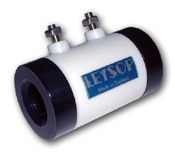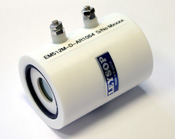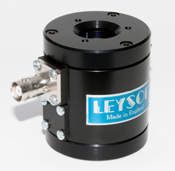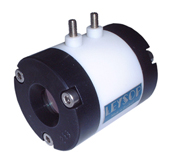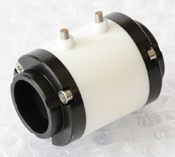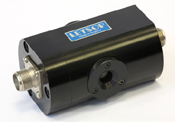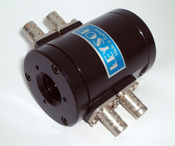Pockels cells from Leysop Ltd.
Devices for Every Application:
Q-switching, Regenerative Amplifiers & Pulse-Picking etc.
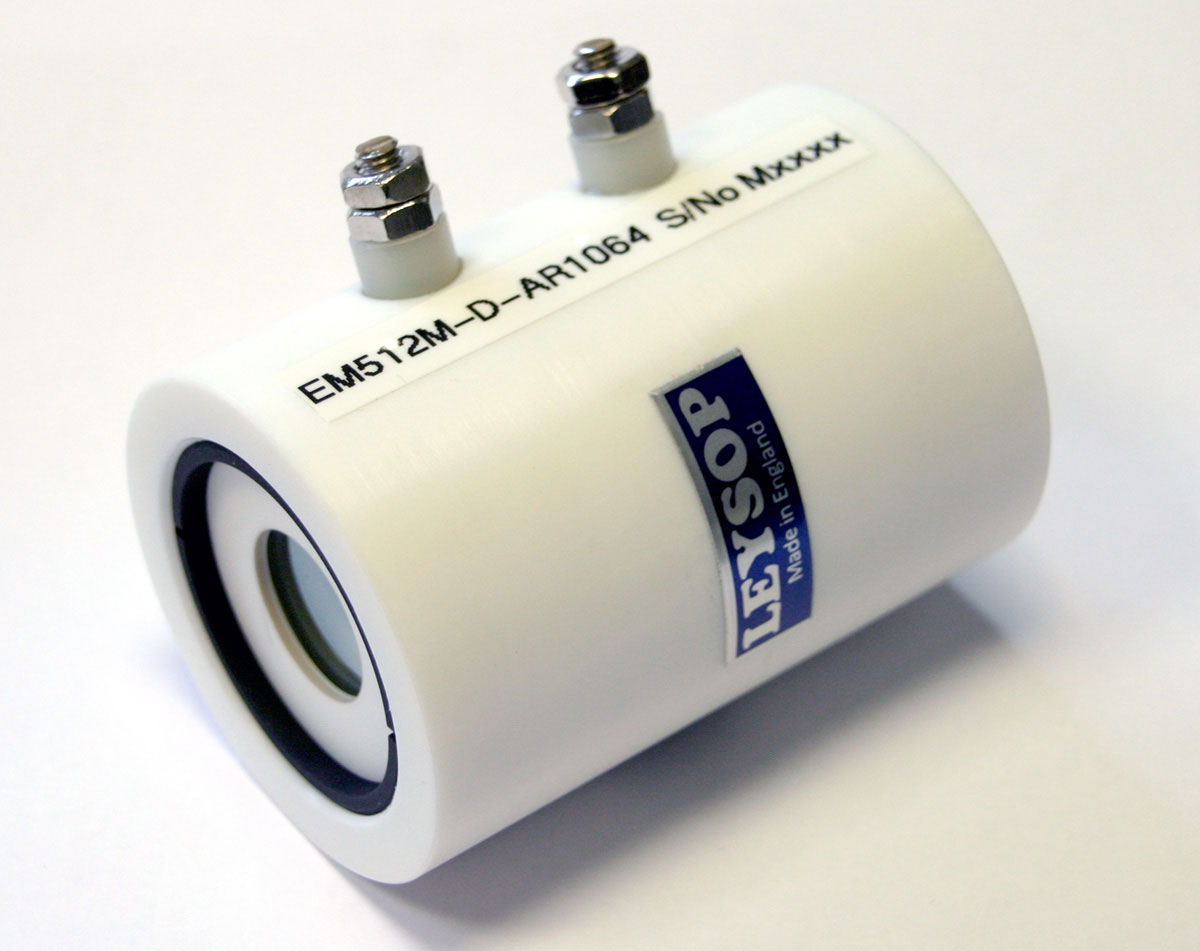
Background
It was once said by none other than Theodore Maiman (or probably many times because it is a cool soundbite) that "A laser, is a solution seeking a problem." We all know of course that now the laser is ubiquitous in our modern lives so I guess they found enough problems! Well in many ways the same thing could be said of the science behind the Pockels effect, discovered in 1893 by Friedrich Pockels after whom it is eponymously named. For many years then only a curious scientific property of certain classes of crystal (specifically ones lacking a centre of symmetry), the Pockels or linear electro-optic effect had no real useful application until the invention of the laser which provided a source of coherent and easily collimated light (both properties which are generally preferred when used with Pockels cells).
The defining feature of the Pockels cell is that birefringence is induced (or changed) by the interaction of an electric field within these classes of crystals. Polarized light, if applied to the Pockels cell correctly, will be modified by the Pockels cell. We speak in terms of the retardation produced by the Pockels cell - this refers to the relative delay introduced between one polarization component and the orthogonal component as they propagate through the crystal. At a quarter wavelength retardation a linear input polarization is converted to either left or right-handed circular polarization, at a half wave of retardation the polarization is again linear but rotated through 90°, just like in quarter and half wave retardation plates made from say quartz. The degree of retardation produced in the Pockels cell though is linearly dependent on the applied voltage and so the voltages which provide quarter wave and half wave retardations are considered important enough to be given special status. The values of the quarter and half-wave voltages will depend on the electro-optic (EO) material used, the wavelength of the source, and typically the geometry of the crystals. Generally the voltages required for most operations range from hundreds of voltage up to as high as 10kV or more - luckily we have you covered with those as we manufacture a range of high voltage pulse drivers and amplifiers and also work closely with specialist manufacturers so that we can provide you with a complete solution.
Applications
Q-Switching
This is probably the first application which comes to mind for people because the unique combination of rapid switching (even down to sub-ns with appropriate high voltage drivers), low insertion loss and high contrast between on and off-states make the on-demand generation of giant-pulses from energy stored in a laser cavity more efficient faster than alternative technologies such as acousto-optic (AO) devices. Essentially the Pockels cell is acting as a polarization filter which in a typical example will hold the circulating polarization state in the laser cavity such that there is a high insertion loss (low-Q) when no voltage is applied to the Pockels cell. This sounds perhaps counter-intuitive but whilst this high loss state is occurring, the laser medium is being pumped to place the material in a meta-stable excited energy state and as long as the rate of pumping exceeds the cavity losses energy will be stored in the laser medium. At a suitable point the appropriate voltage is applied to the Pockels cell and it switches the polarization to one with low cavity loss (high-Q) and because of the principle ofstimulated emissions, the stored energy is released rapidly as a single, short duration high energy pulse.The most common type of Pockels cell traditionally has been the longitudinal field KD*P Pockels cell. These offer large working apertures at moderately low cost (established materials and technologies) and high optical damage thresholds. They are available commonly for Q-switching ruby, neodymium or ytterbium doped YAG and similar wavelength sources but others are continually being developed and we will of course continue to offer solutions tailored to specific requirements, not just a few generic options.
Recent developments of high average power (up to hundreds of watts) and high repetition rate (MHz regime) Q-switched lasers have meant that other materials such as beta-BBO and RTP are often more suitable and we can offer Q-switches in these materials in apertures up to as high as 10mm.
Regenerative Amplication
Here the Pockels cell is again used intra-cavity but to switch a pulse into a cavity where it is stored and amplified on each subsequent round-trip pass. After sufficient passes, the required energy is attained and the Pockels cell switches the optical pulse out of the cavity. There are a number of modes of operation but the most common in a linear cavity is to use an intra-cavity quarter wave retardation plate which in double pass will rotate the polarization through 90° and switch the pulse out after just one round trip. A Pockels cell with no voltage applied does not change this situation but when a quarter wave voltage is applied it too produces a half wave retardation on double pass so the polarization is not switched. The light can therefore theoretically circulate indefinitely with minimum loss so gains energy on each pass until the voltage on the Pockels cell is either switched to zero or half wave retardation.The main requirements for a Pockels cell used for a regenerative amplifier are obviously low static insertion loss and high switching speed on both the switch-in and switch-out transitions. Many regenerative amplifiers are used to produce high output powers and often at high repetition rate. The obvious choice here then is a BBO Pockels cell which scores excellently on both parameters and we can even provide water-cooled versions for the highest powers, please enquire. RTP is also an excellent choice for high frequency applications where average powers are more modest.
Pulse Picking and Amplifier Isolation
Here the Pockels cell is used extra-cavity and it is not used in the pulse generation process itself. It's main application is to select a single or train of pulses at a reduced rate from a laser which is working at a higher frequency than desired. Why not just run the laser at a slower frequency? This is often not practical because for example in a typical ps or fs laser the rate of the pulses is determined by the length of the cavity and to make a slower pulse train would require an excessively long cavity. Because the Pockels cell can easily be switched on and off with transitions of a few ns or less, selecting pulses from 100MHz pulse trains is quite straightforward (and using our UPC model Pockels cells we have even selected single pulses cleanly from 1.5GHz pulse trains). One thing to note is that because the Pockels cell only modulates polarization state, a suitable polarizer must be used after the cell to analyze the polarization into an intensity modulation / shuttering action. The same arguments for Pockels cell material choices as for Q-switching and regenerative amplification generally apply although as this is almost always a half-wave application (90° polarization switching), lower operating voltage devices can be useful.It should be obvious that the same fast on-off switching capability is useful for amplifier isolation where a Pockels cell allows the pulse to pass through when in zero volts mode and then quickly switches to half-wave volts once it has passed through so that any reflected energy from subsequent amplifier stages is switched in polarization and dumped by a polarizer before the cell. This form of active isolation is common in large systems where the larger beam diameters are not always compatibe with passive alternatives such as Faraday isolators.
Pulse Slicing and Removal of Pre-Pulse / ASE
It is often a requirement to shorten an optical pulse, sometimes to create a simlar Gaussian like shaped pulse or other times to generate a nearly flat-top energy profile with the fastest possible rise and fall times. Such pulses are often applied to amplifiers to generate much higher powers. Amplifiers like the regenerative amplifiers described above often have a low-level background of smaller pulses or amplified spontaneous emission (ASE) which because of the non-linear nature of the gain of amplifiers can end up becoming very significant. In the TW and PW lasers in which many of our Pockel cells are installed, these spurious signals can easily reach many joules of energy which because of the quirks of such amplification systems can end up hitting the target before the main pulse. This produces unwanted heating effects in the target region which can destroy the high energy physics of the experiment. An ultra-fast Pockels cell then that can isolate a ps or fs pulse from all other pre and post-pulse spurious signals can produce an extra 30dB+ of contrast at the input to the laser which equates to even larger dynamic range gains after amplification. Our UPC models are perfect for this and are available as standard with 6mm or 8mm aperture and to special order with up to 10mm aperture and in single or double crystal options (for halved switching voltage).Other Applications
The above by no means describes the entirety of the applications for which Pockels cells are used or for which we supply them. Whatever your application there is a very good chance that we have been supplying Pockels cells for it for years so don't be embarrased to ask, give us a call or drop us an email to discuss your needs 😉.
On the right hand sidebar you will see the links to some applicaiton notes and also the main Pockels cell models and types which we offer but as we always say, there are so many options which we can offer including semi and totally custom models, even if you do not see it here we probably do make it.
